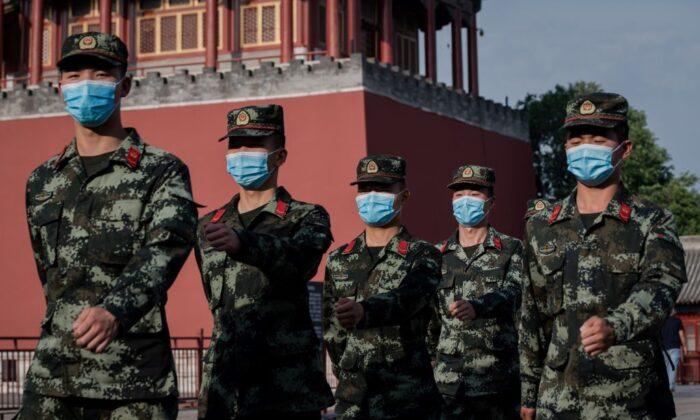Despite its rapid military modernization, China may not be ready for a large-scale war.
Commentary
The Department of Defense (DOD) has published its annual report on the People’s Liberation Army, outlining the strategies, forces, and capabilities Beijing aims to employ to achieve its goal of national “rejuvenation” by 2049. Despite its rapid military modernization, China may not be ready to fight and win a war because of an economic slowdown and other challenges.
The 2022 U.S.
National Security Strategy identifies the People’s Republic of China (PRC) as the “pacing challenge,” the sole competitor with the intent and growing capacity to displace the United States as the global hegemon and reshape the international order in favor of the Chinese Communist Party (CCP). Central to this ambition is the CCP’s
comprehensive strategy to achieve the “great rejuvenation of the Chinese nation” by 2049, focused on five interconnected areas.
According to the 2024
DOD Annual Report on Military and Security Developments Involving the PRC, the seizure of Taiwan is pivotal to CCP leader Xi Jinping’s rejuvenation efforts, as Beijing views competition with the United States as a major obstacle to becoming the preeminent global power.
The PRC’s
national strategy prioritizes strengthening its political, social, economic, technological, and military capacities to enhance and project national power. In tandem, its foreign policy aims to establish a “community of common destiny,” a vision of global structures reshaped to align with the CCP’s goals.
To realize these ambitions, the PRC has launched several key initiatives.
The Belt and Road Initiative (BRI) seeks to connect the world with infrastructure networks that reinforce the CCP’s influence.
The Asian Infrastructure Investment Bank provides an alternative to Western-led financial institutions by funding development projects.
Regional platforms such as the Shanghai Cooperation Organization and the China–ASEAN Cooperation Framework promote security, trade, and political collaboration, consolidating China’s leadership in Asia and Eurasia.
The Digital Silk Road, a BRI component, focuses on dominating global technology standards through investments in telecommunications, e-commerce, and artificial intelligence (AI).
Meanwhile, the Global Development Initiative and Confucius Institutes enhance China’s global image through cultural diplomacy and soft power outreach.
China’s
economic policy in 2024 faced significant challenges, including a slowing economy, declining foreign direct investment, and a severe debt crisis in the real estate sector. To address these issues and reduce reliance on the U.S.-led economic order, Xi has prioritized technological self-sufficiency, advanced manufacturing, and economic stimulus. However, these efforts have yet to resolve China’s economic difficulties or restore the rapid growth seen a decade ago.
In 2023, Xi initiated a sweeping purge of
military leadership, ostensibly to address corruption but likely also to promote loyalists and remove dissenters, positioning the People’s Liberation Army (PLA) for potential conflict. Between July 2024 and December 2024, at least 15 senior military officers and defense industry executives were dismissed, disrupting key modernization projects. Many of those removed were involved in critical equipment development, including nuclear and conventional missile systems.
The most
prominent dismissal was Defense Minister Li Shangfu in October 2023, who had previously overseen all PLA weapons acquisitions as head of the Central Military Commission’s Equipment Development Department from 2017 to 2022. In December 2024, Adm. Dong Jun was appointed as his successor, reflecting Xi’s effort to consolidate control over the commission, which he chairs.
In pursuit of his 2049 ambitions, Xi has prioritized building a “
world-class“ military, initially targeting 2027 for significant progress to coincide with the centennial of the PLA. This goal emphasizes accelerating the integrated development of mechanization, informatization, and intelligentization within the armed forces. China is also advancing modernization in military theories, organizational structures, personnel, and weaponry. These efforts aim to counter the U.S. military presence in the Indo-Pacific and pressure Taiwan’s leadership to negotiate on Beijing’s terms.
In 2023 and 2024, the PLA underwent
significant restructuring, fielding indigenous systems and enhancing its readiness for joint operations across all domains. The Chinese army focused on modernizing its equipment and combined arms training.
The PLA Navy, the world’s largest navy, with more than 370 ships and submarines, expanded operations beyond the First Island Chain. Notable deployments in 2023 included missions with the Yushen-class amphibious assault ship and the Shandong carrier.
Similarly, the PLA Air Force advanced its modernization efforts by integrating advanced systems.
The PLA Rocket Force improved its nuclear and conventional missile capabilities, including intercontinental systems capable of targeting U.S. territories.
Structural changes in 2024 included the dissolution of the
Strategic Support Force, with its aerospace and cyberspace units placed under the Central Military Commission. A new Information Support Force was established to manage military networks and communications. The PLA also prioritized joint logistics and interoperability with reserve, paramilitary, and militia forces.
As part of its push for “informatized and intelligentized” warfare, the PLA invested heavily in information operations, AI, and advanced technologies such as quantum computing. Concurrently, the PLA rapidly expanded its nuclear arsenal, growing from more than
600 operational warheads in 2024 to a projected 1,000 by 2030.
However, persistent challenges, such as limited
military experience, lack of
long-distance logistics, operational inefficiencies, and strategic vulnerabilities—including reliance on foreign energy supplies and internal corruption—undermine the PLA’s readiness. In the event of conflict, the United States could easily blockade the Strait of Malacca, severing China’s vital energy imports and crippling its economy by cutting off exports.
Additionally, structural issues plaguing China’s economy, such as the real estate crisis, declining foreign investment, falling exports, and an aging population, remain unresolved, leaving the nation further unprepared for sustained war. Xi’s centralized decision-making and commitment to achieving “great rejuvenation” may push China toward conflict, even if the country is not fully ready.
Xi’s confidence in the
PLA’s capabilities risks miscalculated escalation, raising the possibility of war. While the likelihood of conflict may increase, China’s ultimate preparedness for a large-scale war remains highly uncertain.
Views expressed in this article are opinions of the author and do not necessarily reflect the views of The Epoch Times.







